Raise your hand if your team is struggling with analysis paralysis. 🙋
It's a common challenge.
As companies experience growth, prioritizing tasks and projects becomes vital for staying organized and efficient. However, many companies struggle to adapt to new processes and face analysis paralysis — or rely on the Highest Paid Person's Opinion (HiPPO) as a decision-making model.
This can lead to biased and siloed decision-making, which slows down productivity and wastes assets — especially across digital channels.
Choosing an established prioritization model keeps every member of your web and marketing teams on track. Effective CX roadmapping balances contributor wish lists against your annual budget, resources, and above all, your customer's digital needs.
How prioritization frameworks accelerate CX roadmapping
Prioritization models get you outstanding returns — organizations investing in strategic prioritization will deliver 40% more value compared to companies that use a “same as last year” approach. And 57% of your projects are more likely to succeed. Not bad.
If you’re an owner or stakeholder, a prioritization model:
- Firmly establishes business goals as your North Star: Get to where you need to be more quickly. If tasks aren’t moving you in the right direction, your team is going nowhere fast.
- Is crucial to ensuring efficient resource allocation: Focus time and money on tasks that significantly impact your market position or customer experience.
- Improves organizational agility: Allow your team to move faster by being able to make decisions in real-time without having to onboard all your stakeholders.
- Helps identify impactful projects: See where tasks land on the ‘high-impact, low-effort’ to ‘low-impact, high-effort’ spectrum with whichever model you choose.
- Eliminates wasteful ideas: Know immediately if a new idea is revolutionary or detrimental by comparing it to current tasks and customer needs.
- Fosters trust among team members: Empower task owners to confidently plan and execute their activities with this structure for buy-in.
Of course, there’s no one-size-fits-all model for prioritization — each business has its own unique goals, challenges and resources.
Blending different prioritization frameworks
As a baseline when roadmapping, know that there are differences between project management frameworks, product frameworks and prioritization frameworks.
- Project management frameworks focus on managing and executing specific projects within a defined timeline and budget. Examples include Agile, Waterfall and Scrum.
- Product frameworks are used to develop and manage a product or service from concept to launch. Examples include Lean Startup, Design Thinking and Jobs-to-be-Done.
- Prioritization frameworks help businesses determine which projects or tasks are most valuable and should be prioritized. Examples include the MoSCoW method, Kano model and Value vs. Effort matrix.
Most enterprise organizations and agencies use multiple versions of these models in their day-to-day business.
Caveat: To be frank, there are between 15 and 20 different models for prioritization alone. It can get overwhelming. Next we'll focus on the prioritization models we most often see when managing digital strategy, customer experience and digital marketing projects.
Choosing the right prioritization model for your web and marketing teams
If your team is establishing a new prioritization model, then you'll want to focus on a minimally viable product (MVP).
Which prioritization model might work best for you right now?
Ask yourself?
- What are your short-term and long-term goals?
- Are you looking to increase revenue, improve customer experience or launch a new product?
- What’s your budget? How big is your team?
- Do you have the necessary tools and technology in place?
- How do decisions typically get made in your organization?
- Are there any specific values or principles that guide decision-making?
With these considerations in mind, let's quickly review the project prioritization models we most often encounter:
Value/Effort Matrix
Provides a simple visual representation of where each task falls on the spectrum of high-to-low-value and high-to-low effort.
- Pro: Flexible, simple and focused.
- Con: Large teams can disagree on the definition of “effort.”
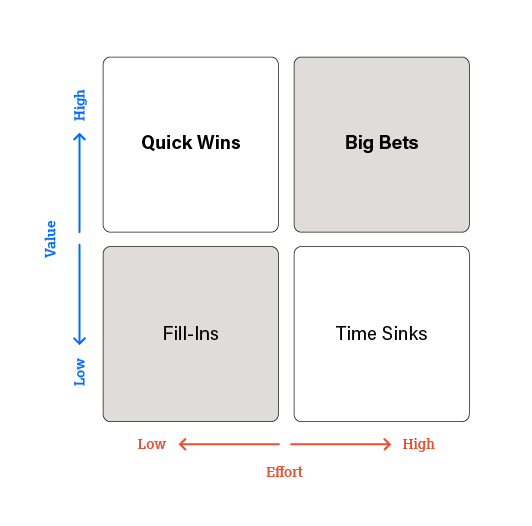
RICE Scoring
Prioritizes projects based on four custom-scalable factors: Reach, Impact, Confidence and Effort.
- Pro: Requires team to make SMART metrics which lessens bias.
- Con: It’s still an estimate and often doesn’tinclude dependencies.
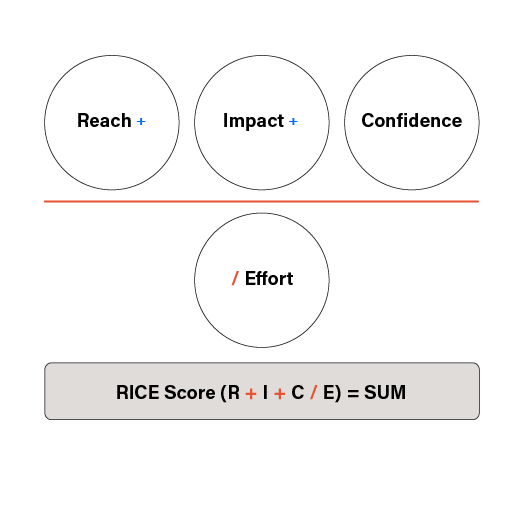
MoSCoW Method
Prioritization technique that categorizes requirements as Must Have, Should Have, Could Have and Won't Have (this time).
- Pro: It’s an intuitive resource for all levels of stakeholders.
- Con: Teams often miss-label “wants” as “needs.”

ICE Framework
Ranks tasks or projects based on their potential impact, confidence in the outcomes and ease of implementation.
- Pro: It’s easy to update, which simplifies estimation.
- Con: Its results are highly subjective.
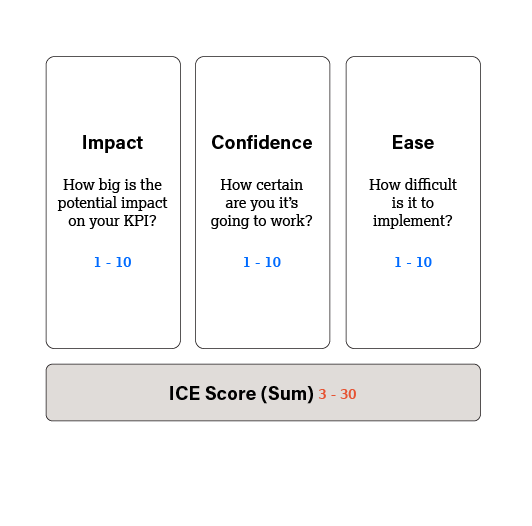
Kano Model
Categorizes features into three types — must-haves, performance and delighters across a client satisfaction grid.
- Pro: Focuses on your knowledge of client expectations.
- Con: It can be time-consuming to do properly.
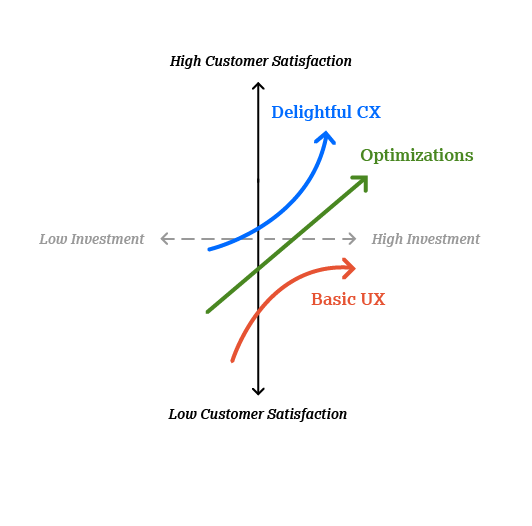
Cost of Delay Model
Considers potential revenue loss, opportunity costs and impact on customer satisfaction.
- Pro: It clearly articulates cost and efficiency metrics.
- Con: Teams can disagree on the definition of “Cost.”
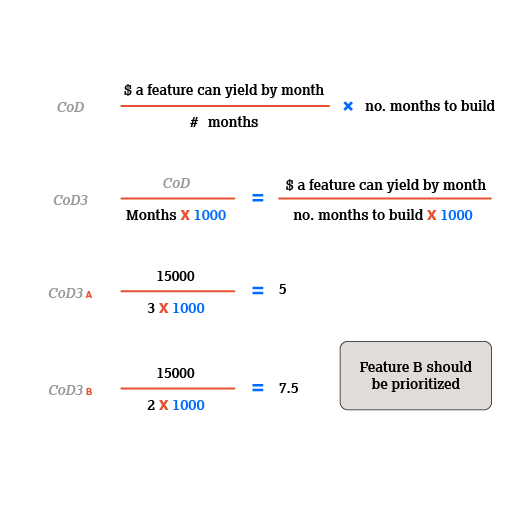
Top prioritization models for customer-focused optimizations
Great digital strategy centers around its users. The MoSCoW method, ICE framework or Cost of Delay models directly consider customer impact and revenue loss for ecommerce companies, but they can all be fitted for your customers.
- The RICE Scoring Model is a popular choice for prioritizing newcomers as it considers customer experience factors alongside technical considerations common in web design and platform implementation projects.
- The Kano Model can also be useful in determining which features will delight your users and differentiate your website from competitors. It’s often used during digital strategy planning and new feature development.
- The Value/Effort Matrix will always be helpful in identifying ‘high-value, low-effort’ tasks for quick implementation. While it can be a bit too simplistic for enterprise organizations, it’s often used in conjunction with other models.
If you're not sure which model is right for you, take one for a test drive. Establish your criteria and stress test it using past or current tasks. Don't be afraid to experiment and adapt as needed — there’s no one perfect model for every organization.
How to use the RICE Scoring Model for web design and development
As an illustration, we’ll use the RICE Scoring Model to prioritize common web design and development projects for a product manufacturing company using Kentico 13.
First, create your scoring framework in Excel or a similar program. Then assign parameters for each column.
Pro Tip: Remember that when you stress test this, you may end up changing these parameters to ensure you’re getting the results you want so do not get stuck here. Make your best assumptions and consult with your partners, stakeholders and team members to choose the best parameters.
- Reach: Some organizations use a simple 1-to-4 system that delineates how impactful a project could befor their audience: (1) few, (2) some, (3) many or (4) all. We prefer to use the percentage of the audience. You could also specify the number of users. For example, if you know your product pages get 2,000 views per day, then Project One in the grid below will reach 2,500 visitors.
- Impact: This exercise determines whether a user would like the feature, want the feature or need the feature.
- Confidence: Here we’re adding a percentage to how confident stakeholders are in what the project is and how it will be received by users.
- Effort: This 1-to-5 scale determines how much development effort is needed: (1) one month, (2) three months, (3) six months, (4) nine months or (5) 12 months.
Interpreting your findings
The numbers often don’t come out exactly as you think they will, though. In the example above, we’ve been planning to introduce content segmentation sitewide, which will increase engagement and sales. However, it takes much more effort than other projects and is not as immediately impactful as the improved product description pages and the dealer finder. The latter will immediately impact sales and or take less effort to complete.
Remember: Your prioritization model, just like your VoC, user personas, and journey maps are living, breathing documents. Your scores are not hard and fast. You still may need to place a bet on a lower scoring item based on your industry experience — content segmentation may score higher on the Cost of Delay Matrix.
With the rise of customer-centricity and the growing emphasis on delivering exceptional customer experiences, prioritization models have become an essential tool for business stakeholders. If you want help leveling up your digital strategy by introducing a prioritization model, give our pros a call.
